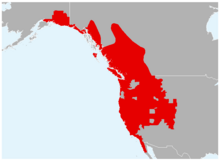Western toad
| Western toad | |
|---|---|
 |
|
| Anaxyrus boreas boreas | |
| Scientific classification | |
| Kingdom: | Animalia |
| Phylum: | Chordata |
| Class: | Amphibia |
| Order: | Anura |
| Family: | Bufonidae |
| Genus: | Anaxyrus |
| Species: | A. boreas |
| Binomial name | |
|
Anaxyrus boreas (Baird and Girard, 1852) |
|
 |
|
| Synonyms | |
|
Bufo boreas Baird & Girard, 1852 |
|
Bufo boreas Baird & Girard, 1852
Bufo politus Cope, 1862
The western toad (Anaxyrus boreas, formerly Bufo boreas) is a large toad species, between 5.6 and 13 cm (2.2 and 5.1 in) long, native to western North America.A. boreas is frequently encountered during the wet season on roads, or near water at other times. When handled adults often vocalize, making a sound like a peeping chick while struggling. It eats any type of insect it can catch. It can jump a considerable distance for a toad. Breeding occurs between March and July in mountainous areas, and as early as January in lower-elevation regions. The female lays up to 17,000 eggs stuck together in strings that adhere to vegetation and other objects along water edges.
It has a white or cream dorsal stripe, and is dusky gray or greenish dorsally with skin glands concentrated within the dark blotches. Its parotoid glands are oval, widely separated, and larger than the upper eyelids. It has a mottled venter and horizontal pupils but lacks cranial crests. Compared to females, males have smoother skin, reduced dorsal blotching, and nuptial pads (thickened skin) on their forefeet during breeding season. In juveniles of this species, the dorsal stripe is weak or absent. Large young have prominent dorsal and ventral spotting and yellow feet.
There are two known subspecies of the western toad:
The range of the western toad extends from western British Columbia and southern Alaska south through Washington, Oregon, and Idaho to northern Baja California, Mexico; east to Montana, western and central Wyoming, Nevada, the mountains and higher plateaus of Utah, and western Colorado. Occurrences of the boreal toad from Yukon Territory, the Northwest Territories, and northwestern and north-central British Columbia have been reported. Southern records of boreal toads in New Mexico have been published.
The ranges of subspecies are as follows:
The boreal toad is found in the Rocky Mountains in aspen (Populus spp.) groves and riparian forests. In Colorado, the largest populations are typically found in areas characterized by willows (Salix spp.), bog birch (Betula glandulosa), and shrubby cinquefoil (Potentilla fruticosa). In the Pacific Northwest, the western toad occurs in mountain meadows and less commonly in Douglas-fir forests (Pseudotsuga menziesii).
...
Wikipedia

